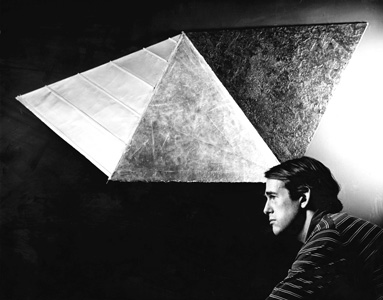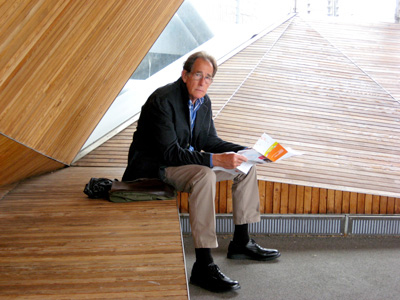Charles Fahlen (1939–2010)
Charles spent his formative years and initiated his artistic interests in the city of his birth, San Francisco, California. From the home garden shed-turned-workshop, he began making jewelry and small sculptures using silver, stone, and exotic wood. Summers spent in Wawona, Yosemite, and the desert around Phoenix, Arizona nurtured his interest in the land, its creatures, and its cultural history, as did the family excursions to Yellowstone, Monument Valley, and other landmarks of the Southwest.
During his college years, his declared major in sculpture broadened to include etching and printmaking, influenced by his mentor professors, Seymour Locks, the sculptor, and John Ihle, the printmaker. Marriage and a move to Los Angeles for graduate studies followed in the early 1960s. While working towards an M.F.A. degree, he pursued an interest in bronze casting and the small pieces produced over those years attracted the attention of the interior designer, Tony Duquette, and earned him the Elsie de Wolf traveling fellowship at graduation. The fellowship and the receipt of a Fulbright grant enabled two years of study abroad with a focus on printmaking. Throughout the 1960s, the subject of his art merged his interest in anthropology, natural history, and metamorphosis influenced by the writings of Franz Kafka.
Returning to the United States in the late 1960s, Charles accepted a teaching position at Moore College of Art (now Moore College of Art and Design) in Philadelphia, Pennsylvania, where:
“He would profoundly, deeply influence scores and scores of students… many of whom will never forget his exacting lessons in art and life.” 1
He began his professional career as an artist here, working mostly in the printmaking media at first. The 1969 purchase of a small house on Gaskill Street and the much-needed “rehab” of the home for his growing family was to have an influence on his art as it drew him increasingly towards sculpture. Additionally, a return to the Yosemite cabin in summer of 1973 resulted in a series of ten small sculptures called Wawona. What he learned in doing the renovations was brought into his studio and the body of work he produced in the 1970s. Trips to local stores for construction materials led to a discovery of the many sources for raw materials remaining in Philadelphia from its manufacturing days. Industrial felt and canvas, fiberglass, pre-fab Masonite paneling, all offered seductive possibilities for use in his sculptures, such as Cracker Jack, 1975 and Better Business, 1976, or Untitled, 1973, a fiberglass pyramid in the collection of the Philadelphia Museum of Art. At the same time, there were many trips to New York City and to SoHo’s emerging art scene, aiming to get museums and galleries to look at the work, and so began in his inclusion in New Generation at Richard Feigen, New York, in 1971, and the 1973 Whitney Museum Biennial.
The move in 1980 to an industrial loft building in Philadelphia’s Northern Liberties district, with its large studio and 18-foot-high ceilings, allowed the work to increase in scale, as did invitations to work on public and private art commissions such as Major, in Philadelphia’s Washington Square neighborhood, at Eighth and Locust Streets, and General Grant, in Chester Springs. The sculptures of the 1980s and 1990s often referenced themes of exploration in the Americas. The American West, along with the view of the dazzling night sky it afforded, offered particular inspiration and remained a frequent touch point for him. Powell’s Knee, 1984; Magellan’s Rout, 1985; Meteor Crater, 1987; Voyager, 1989, or Tehachapi, 1990, come to mind.
A solo exhibition, Terra Incognita, at the Institute of Contemporary Art, Philadelphia, 1991, combined elements of site-oriented work responding to the history of place in the installation piece, Colter’s Hell, and his single-form pieces abstracting land formations, such as Tehachapi, 1990. The exhibition catalogue essay by Stephen Westfall offers an eloquent insight into this body of work. While the 1990s marked an increased involvement in large public art projects, his fascination with puzzles, toys, traps, and cultural myths re-emerged as inspirations for sculptures in the studio (Badlands, and Chiron, 1994).
In 2000, having retired from teaching, Charles returned to California, moving into the home and studio he designed in Guerneville, to give full attention to his art until his death in 2010. His last body of work makes reference to the cosmos, continuing the constellation theme begun in the 1990s with Pandemonium, 1997, Stella Minor, and Untitled, 1999, “A move from landscape to skyscape, taking us back to where it started.” 2 For these last works, he committed himself to using readily available materials, fittings and fasteners, from nuts and bolts to lead fishing weights, brass rod, stainless steel cable, fiberglass resins, etcetera. If he could not find the right item he would make it. The spheres in Flummox and Quibble (2009) began as pet toys and balls which he split in half, and then filled with layers of colored resin before reassembling.
“The process of assembling these humble materials has been left for all to see, synthesized into elegant, enigmatic forms that defy easy explanation, simple means making for a lyrical, playful, but complex form; evident parts making a whole.” 3 They can be seen as playful models referencing imagined constellations, celestial maps, cosmic schematic diagrams, (Out of this World, 2002, Hold Back, 2007) astral fragments (Dark Side, 2008) and/or contraptions for the display of fireworks (Humdinger, 2009). The sculptures are reliefs rather than objects in the round. The shadows cast on the wall by the linear nature of the sculptures enliven and mobilize the works, extending their graphic quality into the space of the viewer.
"Sometimes, to people who aren’t artists, a life dedicated to art can appear to entail terrible risks. Beyond the obvious practical considerations, the tasks and labor of art can seem a nearly mortal gamble. And it can feel that way sometimes to artists themselves: you know well you can give all your years to your work, but you can’t know, not really, if it will ever be understood and appreciated as you would like it to be. Sometimes, on very bad days, you can wonder if you’ll ever do something that satisfies even yourself. And yet, to real artists, artists like Chuck Fahlen, art doesn’t require a faith that things will turn out all right in the end, art itself is a kind of faith. Because in truth, the life of art is a gamble that can’t be lost; giving oneself to art, which can seem such a risk, in fact risks nothing, because the tasks and labors of art are acts that fulfill themselves in their doing. The life of art itself is faith, and devotion, and love.”
—C.K. Williams, For Chuck, 2010


